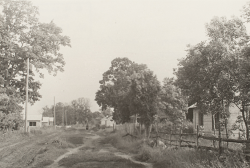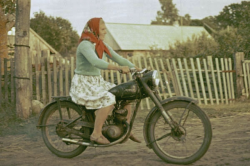Ruhnu during the Soviet period 



Ruhnu was first occupied by the Soviet Union in 1939, during the World War II it was the last part of Estonian territory Soviet forces liberated in 19th December 1944. On 26th September 1950 Ruhnu Commune was renamed a village soviet and was attached to the Pärnu District (raion), where the island remained until November 1986. The post-war years (1945–48) were characterised by rapid changes in the population; many of them came from the neighbouring island of Kihnu. The property of the former owners, which had been left at their disposal under management contracts, was declared property of the state and had to be bought out. A weather station was set up on Ruhnu in 1945, a seven-year school reopened in 1946, and a shop in 1947.
The period when there was an independent collective farm (kolkhoz) on the island (1949–70) brought steady economic and cultural development. The agricultural trend in the first years of the collective farm did not justify itself, as the main activity on the island had always been fishing and sealing. In 1951 the agricultural artel Ruhnu was reorganised into the collective fishery Kommunismi Majak (Lighthouse of Communism). Relatively good opportunities were left for private farming, which helped attach the residents to the island. Good catches of fish and seals and a much more stable managing staff than before brought the collective fishery relative prosperity. During twenty years more than a dozen production and public buildings were erected on the small island, six trawlers and 31 smaller fishing vessels were acquired and help was given to members of the collective farm in the building of numerous houses.
In 1958 Ruhnu received an electric power plant driven by a diesel engine, and a new village hall was completed in 1959. Extensive land improvement work was carried out in the mid 1960s, a new central highway was built and the construction of a port began. In 1965 the first games between the neighbouring islands of Kihnu and Ruhnu were held. Organised for five times until 1971, the big cultural and sports festival attracted attention throughout Estonia.
The 1970s brought a major setback in the life of the island. The main reason was a severe storm of 2 November 1969, which wholly destroyed the port, and liquidation of the local collective fishery in 1970. The number of population declined fast, from 222 in 1967 to 99 in 1973. In the composition of the big Pärnu Kalur collective fishery the island was reduced into a backwater to which no serious attention was paid. Fishing as an industry was practically wiped out.
An interesting peculiarity is revealed in the life of the island: if in mainland Estonia compulsory membership in collective farms led to departure of peasantry from the village, then in Ruhnu mass departure only began in connection with the liquidation of the local kolkhoz. By 1979 only 58 permanent inhabitants had remained on the island, most of them employed by Pärnu Kalur and pensioners. A new stage in the life of Ruhnu Island began when it was assigned to Saare County in 1986.
Further reading
- Märt Kapsta. Ruhnu aastail 1944–1987. – Saaremaa Muuseum: kaheaastaraamat 2003–2004. Kuressaare, 2005 (in Estonian; Summary in English)
Created in 2014






